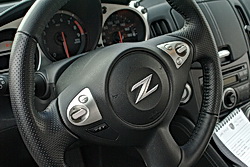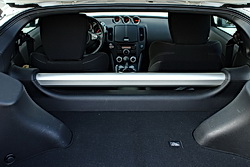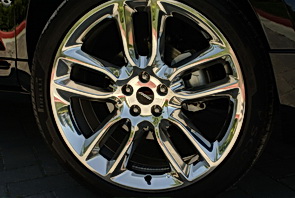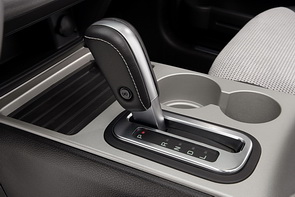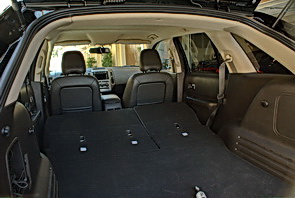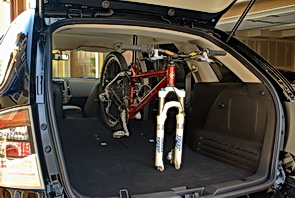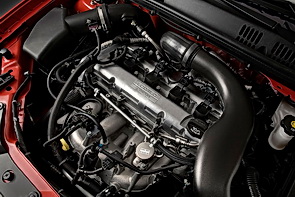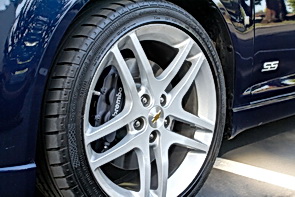Pros:
- Stiff, sports-car suspension
- Blazing acceleration
- Seriously comfortable seats
- Excellent handling ability
- Simple, clean interior (not a lot of bells and whistles)
Cons:
- Stiff, sports-car
suspension (seemed to have been tuned for the track, because it barely budged) - Blind spots that you could miss a bus in
- Not much more room inside for anything but an extra passenger , a purse and a briefcase in the back
Ruling: Z can spin doughnuts around a candlestick! Heck, who needs a candlestick, let’s DRIVE!!!!
Introduction:
The Nissan 370Z is all new for 2009. Almost every piece and component of the 370Z has been re-designed by Nissan. I read a review stating: “this is the fastest production Z ever built.” Amen to that. The car (especially the rear) is definitely chopped over the older versions, has wider-flared fenders, a shorter wheelbase, a lot less room inside than the earlier versions from the 90’s, but it now has sportier lines and is one sharp car! Most of all, it is a blast to drive (it knocks the socks off of the 4th generation version that I owned)!!! I haven’t driven a Z (or even ridden in one) since I had my 1993 300ZX, and this new version did not disappoint.
Fuel Economy:
Advertised: 18 in the city, and 26 highway (22 combined)
Actual: 22.3 mpg, and I drove this car HARD (hard for me, that is…). When I was behaving myself and driving along long expanses of freeway, the mileage was inching up to 23+ mpg.
Driving Impressions:
This car was simply amazing. Impressive acceleration. Seriously tight turning radius (oh, I miss that!!!). Feels like you could do a 360-degree turn in a single lane of a 2-lane road. Serious sports-car ride (you could feel every thump in the road), but let’s be real - this ain’t no luxury car… I thought the mileage was really decent (considering how I was driving) given the horsepower. With a V6 engine
Build:
Not a squeak, rattle or anything else to indicate poor construction. The hood was heavy and closed solidly (the engine is pretty compact, leading me to believe it would be hard to work on yourself). The rear hatch also closed solidly, although the first few times with it, I was rather timid and it didn’t fully latch. Once I figured out that I wasn’t going to break it, it latched every time. The doors were solid, without feeling overly heavy. All of the interior storage doors (glove box, center console) were constructed solidly. Interior and exterior door handles were easy to grasp, well-placed and well-built.
I really appreciate the fact that this trim line was simple. No power seats. No sun roof. No navigation system. To me, all of that stuff breaks and ends up costing more money. I think the car is put together extremely well, with just the simple necessities for pure driving bliss - nothing more.
Interior Comfort and Ergonomics:
The good:
Where do I start?
The instrument panel is simple, and customizable. I set the information display to monitor my mileage, which helped me to keep me in check. Easy to see, easy to read, and simple, yet effective.
I really like the push-button ignition controls and proximity keys. Nice to not have to insert a key into the ignition, unless you really want to.
Having not sat in the passenger’s seat, I can’t say much about it. But I can definitively say that I was able to
Other stuff: the one-touch auto up and auto down windows work very well. The cruise control was easy to understand and easy to set. LOVE the speed-sensitive automatic door locks. There’s a nice little package shelf behind the passenger seat. Perfect for my purse, and then I didn’t have to worry about knocking it over and spilling the contents if I’d left it on the floor. Definitely not a lot of fancy features, but the ones that are included are well thought-out and very handy to have.
Everything in the interior area of the vehicle blended and matched perfectly. The black interior color was nicely offset with the silver metallic trim.
The bad:
The only really bad thing, and it does not apply to me: If you are tall, 6′3″ or above: you won’t be able to ride in, or drive this car. It’s really intended for those under 6 feet. The seats will only slide so far back, and then it’s all about how flexible you are, and how long you’re comfortable being folded up in your seat!
The ugly:
The blind spots. If you look up “blind spot” in the dictionary, there should be a picture of the view out of this car. Backing up was scary. I nearly backed into 3 full-sized cars (not to mention pedestrians) in the grocery store parking lot. And it wasn’t for not looking! I simply could not see them! Trying to look over your left shoulder is useless. The rear “windows” are sort of a joke. I think the exterior rear-view mirror areas are actually larger. What it forces you to do (and I’m sure some people are better at this than others), is to keep track of and remember where every single vehicle is located in your proximity at all times. Once I started keeping track, it was a non-issue. But I had to be on high-alert 100% of the time.
Performance:
I’m really fortunate that I didn’t get a ticket. It was nearly impossible not to go 70+ mph, and I saw 85 mph more times than I’m willing to admit. EGAD. The 332 HP, 3.7 Liter DOHC V6 engine, with Variable Valve Event and Lift (VVEL) really makes the 370Z get up and move. Downshifting quickly decelerates the car or sets you up for a nice acceleration around traffic, an obstacle, whatever might be in your path. The car was effortless to shift and the clutch was not too tight, not too loose - just right. Even when the engine was spun up, the engine didn’t feel or sound like it was whining too loudly.
I feel that this is one car which will appeal to the person wanting a true sports car, but who doesn’t want to pay $50+k for it. My favorite passenger, who used to drive a Porsche (and whom races street motorcycles), was suitably impressed with its acceleration and torque. I was beside myself, either giggling or with an ear-to-ear grin every single time I used the go-pedal.
Handling:
Accelerating onto the freeway? Bring it on! Passing a road boulder? Bring it on! Going uphill, driving a curvy road, fitting into a tight parking spot, a Sunday drive up the coast, running to the grocery store, dropping some kid who’s trying to challenge you at a light, check, check, check, check, check and check. The ability to dodge a piece of lumber which suddenly appeared in your path on the freeway? Priceless. The nimble handing and fast response of the Z will not let you down in any of the situations above, or most any others that you could throw at it (notwithstanding outrunning the police. I make no warranties here…).
The tight turning radius, lowness to the ground, horsepower, curb weight, etc. all contribute to the fantastic handling ability of this car.
Styling:
In a word: sexy (HOT also comes to mind…).
The Z looks like it’s screaming down the road, even when it’s standing still. It makes your heart race just walking up to it, as it’s so beautiful to look at, and at least for me - I simply couldn’t believe that I had the opportunity to drive one for a few days.
Value:
For around $30k, you get a real, 2-seater sports car. You don’t get a lot of bells and whistles however, as the Z is devoid of a lot of the features of the fancy luxury cars, or the luxury sport vehcile
As for safety, the 370Z has Nissan’s Advanced Airbag System (AABS) with dual-stage supplemental front airbags, seat-mounted side impact airbags for both the driver and passenger, roof-mounted side-impact air curtains, active head restraints, seatbelts with pretensioners and load limiters for both passengers, Anti-Lock Braking System (ABS), Electronic Brake Force Distribution (EBD), Brake Assist, Vehicle Dynamic Control (VDC), Tire Pressure Monitoring System (TPMS), Energy Absorbing Steering Column, Front and Rear Crumple Zones, and Traction Control System (TCS).
Additionally, the Nissan Vehicle Immobilizer, and Vehicle Security System (VSS) are effective theft-deterrents.
Having been in an accident in a 300ZX, I can say that the Z was probably not truly designed for impact. The car was not seriously damaged when I was hit, but I was (probably through my own fault of not having my headrest at a reasonable height). However, Nissan does seem to go out of its way to make the new Z as safe as possible for the consumer. Given the safety record of the rest of the Nissan fleet (and a boatload of safety improvements since the early 90’s), I do have to say that I felt safe the entire time I was driving this car.
Who should buy it?
- Ideally, the person who would want to buy this car has grown or no children (teenagers WILL want to borrow the car - think Ferris Bueller or Risky Business - you have been warned…).
- If it’s your primary car, you don’t have a large family, lots of dogs, love to drive to the mountains in the snow, or haul around a lot of sporting equipment.
- IF any of the above is you: you can afford a 2nd car or you want a car solely for its driving pleasure, then this is your car! I’ve said a zillion times that if I could ever afford a 2nd car (and I could learn some self-restraint behind the wheel), I’d get another Z in a heartbeat.
If you want a true sports car without breaking the bank, one that even gets good mileage, then this is your car!



